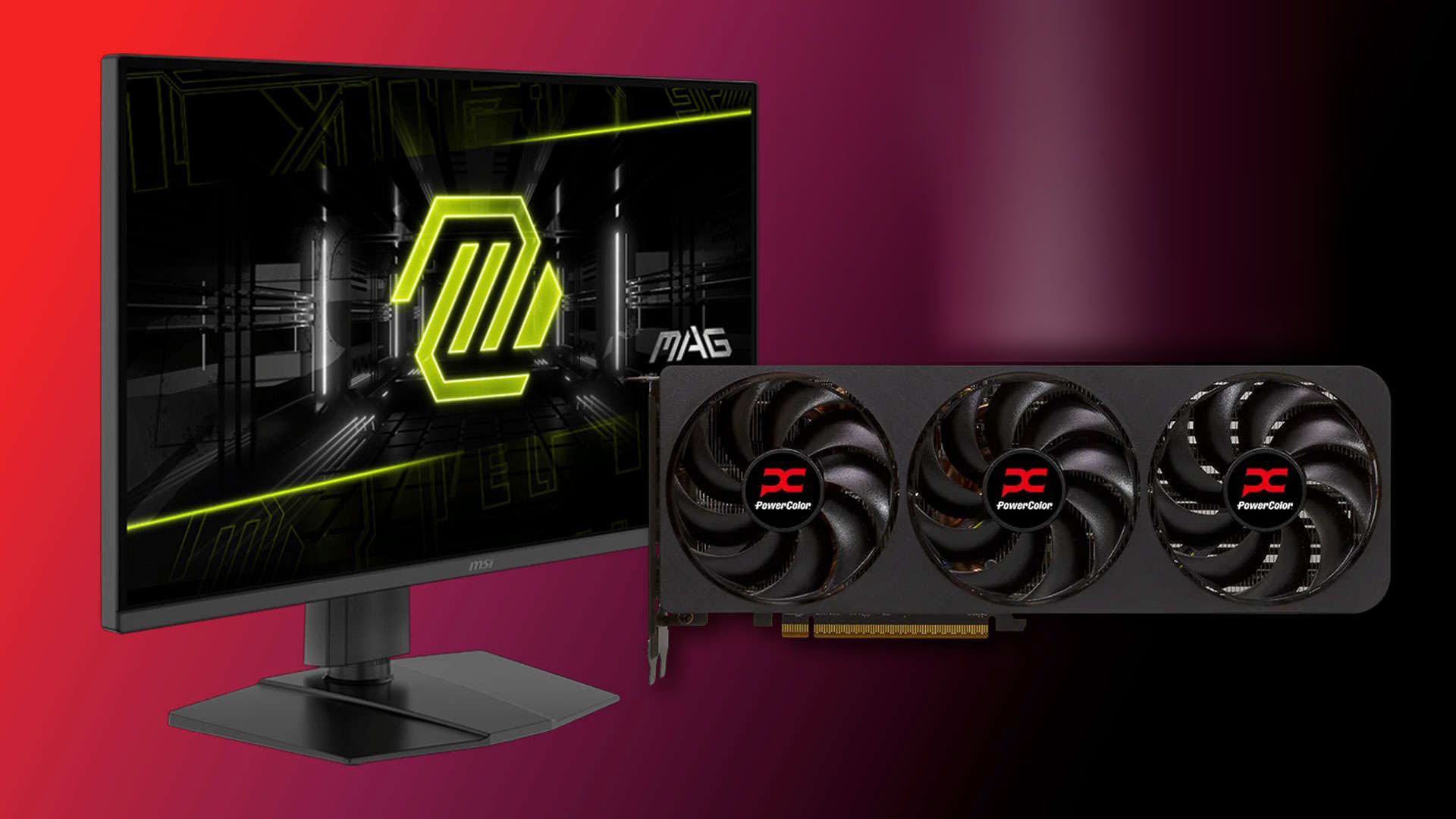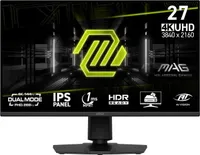In the era of stratospheric RAM prices, putting a new GPU in an old PC might be your best upgrade bet, but be sure to grab the right monitor, too
You can work around an old CPU, but you can't fix 1080p and 60Hz

DDR5 prices are continuing to climb toward the sky, and the morale of PC builders is cratering along with them. What good is a shiny new Ryzen 7 9800X3D when a RAM kit to go with it costs almost as much or more than the CPU itself? If you're feeling DDR5 pricing pain this Black Friday season, you might be considering a GPU upgrade instead. But if you're contemplating a new graphics card, make sure that your monitor won't hold you back from the best gaming experience.
Now is a good time to grab a graphics card, as prices on many of the best GPUs, like AMD's Radeon RX 9070 XT and Nvidia's GeForce RTX 5070 Ti, have finally fallen to MSRP or even below. And GPU price increases are likely on the horizon due to the AI data center gold rush that's consuming every available silicon wafer.
But throwing a powerful new GPU into your existing system won't necessarily improve your gaming experience all by itself. You'll want to make that upgrade without limiting a GPU's utilization or spending its performance potential on rendering wasted frames that don't get displayed.
How pairing a new GPU and a new monitor could be your best upgrade option
If you're rocking a five- to eight-year-old CPU and a 1080p monitor of a similar vintage, your CPU might not be able to keep up with the overhead of feeding a modern GPU at what is now considered a low resolution.
And even if you are suddenly seeing much higher frame rates in your performance monitoring overlay after an upgrade, you might not actually be enjoying a smoother, more responsive experience if you're still rocking a 60 Hz monitor.
Our recent RTX 5050 testing shows that, on average, upgrading to even a relatively affordable graphics card like an RTX 5060, Radeon RX 9060 XT, or RTX 5060 Ti will give you output frame rates well beyond what a 1080p60 display can fully show.
Hook up an RTX 5070, RX 9070, RX 9070 XT, or RTX 5070 Ti to that same monitor, and you're just rendering even more frames that never get properly displayed. And that's just with native rendering, not with upscaling.
Get Tom's Hardware's best news and in-depth reviews, straight to your inbox.
The advent of the DLSS, FSR, and XeSS upscalers and framegen tech like Nvidia's Multi Frame Generation means that your monitor's native resolution and refresh rate are no longer hard caps on performance. You can now balance output frame rates and image quality at will. But if your display has a low resolution and refresh rate to start with, it greatly limits your degrees of freedom when balancing those factors.
Enabling upscaling on a 1080p display, and thus targeting a 1080p output resolution, means DLSS, FSR, and XeSS have lower-quality input data to work with than they would when upscaling to a target resolution of 1440p or 4K. Any performance you add this way is coming at the expense of degraded image quality.
Targeting 1440p or 4K gives upscalers more pixels as input at the same quality settings and, especially in the case of DLSS 4's transformer model, means that you might actually see higher-quality output than with modern games' sorry TAA implementations at native resolutions. You just need the extra pixels in your display to begin with.
Getting the best results from upscaling and framegen with an older CPU
To figure out what potential upgraders with older PCs might face by only upgrading their graphics cards, we pulled a five-year-old Ryzen 9 5950X off the shelf as a representative of the wildly popular family of Zen 3 CPUs and paired it with the thoroughly modern Radeon RX 9070 XT. We then hooked up our ROG Strix XG27UCS 4K 160Hz monitor and got to work with Marvel's Spider-Man 2, a notoriously CPU-heavy game.
Resolution | Upscaling | Framegen | Average FPS | GPU Utilization |
1920x1080 | None | None | 108.8 | 88% |
1920x1080 | FSR 4 Balanced | None | 114.7 | 84.5% |
2560x1440 | None | None | 99.7 | 95% |
3840x2160 | None | None | 62.7 | 99% |
3840x2160 | FSR 4 Quality | None | 86.9 | 99% |
3840x2160 | FSR 4 Quality | FSR FG On | 164.8 | 99% |
With a 1080p monitor running at native resolution, the 9070 XT is already bottlenecked by the 5950X in Spider-Man 2, demonstrating just 88% GPU utilization while delivering 108 FPS. Your first instinct in this situation might be to enable FSR 4 Balanced upscaling, and that change does goose output frame rates to a 114 FPS average, but it only worsens the GPU utilization problem, lowering it to just 84.5%.
We're getting higher performance, but perceptibly worse image quality than native 1080p, and we're leaving resources idle on our $600 GPU. This isn't the way.
Going in the other direction, dialing in native 1440p Very High settings results in a 99.7 FPS average in Spider-Man 2 with 95% GPU utilization. This is better. We only lose a bit of performance versus 1080p, in exchange for a higher output resolution and better image quality, and we're using most of our GPU resources. Even so, further optimization is possible.
Stepping all the way up to 4K Very High essentially maxes out our GPU, which is now at 99% utilization, but output frame rates fall to just 62 FPS on average. Now we're losing smoothness. Dialing in FSR 4 Quality at 4K brings back an 87 FPS average and 99% utilization, which is much better, but we can do more.
The final step is to add FSR framegen, which boosts output frame rates to 164 FPS, on average, while keeping GPU utilization at 99.88%. Because the processing for framegen is occurring on the GPU, it doesn't place additional load on the CPU, as naively enabling FSR Balanced and Performance might.
With FSR 4's Quality preset and framegen enabled on our 9070 XT paired with a 4K display, we get higher frame rates and smoother perceived output than native 1080p, while avoiding CPU bottlenecks and giving FSR 4 room to deliver superior image quality. It's a win-win, and you can't tell that you're gaming on a five-year-old CPU at all.
Low-cost, big-time upgrades
That's a lot to digest, so in summary: If you're considering a GPU upgrade for an older system, make sure that you can keep as much of the work on the graphics card as possible. Counterintuitively, that may mean using higher resolutions, higher-quality upscaling settings, and framegen rather than performance-oriented upscaling settings alone. To enable all that tuning, you need a good high-resolution, high-refresh-rate monitor to go with your new GPU.
All that might sound snobbish, but the joy of PC gaming is that you can still be a snob and a penny pincher all at once. Upgrading to a high-refresh-rate 4K display doesn't have to be expensive at all.
For just one example, MSI comes in clutch with the MAG 275UPD, which is just $229.99 and offers dual 4K/144Hz and 1080p/288Hz refresh rate modes. Even better, Newegg will knock another $30 off with the promo code BFEFE82.
The MSI MAG 275UPD is a 27-inch gaming monitor with a 4K IPS panel. It supports Adaptive-Sync and includes HDMI 2.1 along with DisplayPort 1.4a connectivity.
Just $200 for a display of this caliber—with wide color, variable refresh rates from 48-144Hz, and a fully adjustable stand—is crazy. And unlike many other PC components, a high-quality LCD monitor like this should last for a good long while.
Low prices on long-lasting components that might let you extend your existing PC's lifespan is the kind of Hallmark-movie Black Friday story we dream of, and here one is. Grab a new GPU and the right display to go with it, and you'll enjoy smooth, detailed gaming for many years to come.
Best gaming laptop deals | Best monitor deals | Best PC and laptop deals | Best SSD deals | Best CPU deals | Gaming Chair | Best hard drive deals | Best PC case deals | Best Dell and Alienware deals | Best 3D printer deals | Best PC peripherals deals | Best motherboard deals | Best CPU cooler deals | Best gaming chair deals

As the Senior Analyst, Graphics at Tom's Hardware, Jeff Kampman covers everything to do with GPUs, gaming performance, and more. From integrated graphics processors to discrete graphics cards to the hyperscale installations powering our AI future, if it's got a GPU in it, Jeff is on it.
